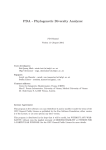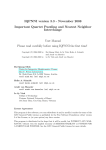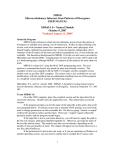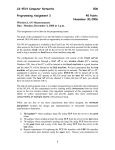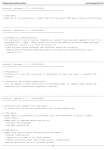Download PDA - Phylogenetic Diversity Analyzer
Transcript
PDA - Phylogenetic Diversity Analyzer PDA Manual Version 0.5.1 (Apr 2008) Copyright 2006-2008 by Bui Quang Minh, Steffen Kläre, and Arndt von Haeseler Bui Quang Minh Center for Integrative Bioinformatics Vienna, Max F. Perutz Laboratories, Dr. Bohr-Gasse 9/6, A-1030 Vienna, Austria. email: minh.bui (at) mfpl.ac.at Steffen Kläre Center for Integrative Bioinformatics Vienna, Max F. Perutz Laboratories, Dr. Bohr-Gasse 9/6, A-1030 Vienna, Austria. email: steffen.klaere (at) mfpl.ac.at Arndt von Haeseler Center for Integrative Bioinformatics Vienna, Max F. Perutz Laboratories, Dr. Bohr-Gasse 9/6, A-1030 Vienna, Austria. email: arndt.von.haeseler (at) mfpl.ac.at Legal Stuff This program is free software; you can redistribute it and/or modify it under the terms of the GNU General Public License as published by the Free Software Foundation; either version 2 of the License, or (at your option) any later version. This program is distributed in the hope that it will be useful, but WITHOUT ANY WARRANTY; without even the implied warranty of MERCHANTABILITY or FITNESS FOR A PARTICULAR PURPOSE. See the GNU General Public License for more details. Contents 1 Introduction 1.1 3 Methods . . . . . . . . . . . . . . . . . . . . . . . . . . . . . . . . . . . . . . . 2 Command-line options 2.1 4 4 General options . . . . . . . . . . . . . . . . . . . . . . . . . . . . . . . . . . . 5 2.1.1 <file name> option . . . . . . . . . . . . . . . . . . . . . . . . . . . . 5 2.1.2 <output file> option (NEW!) . . . . . . . . . . . . . . . . . . . . . . 5 2.1.3 -k <num taxa>, -k <min>:<max>, and -k <min>:<max>:<step> option 5 2.1.4 -o <taxon> option . . . . . . . . . . . . . . . . . . . . . . . . . . . . . 6 2.1.5 -e <file> option . . . . . . . . . . . . . . . . . . . . . . . . . . . . . 6 2.1.6 -i <file> option . . . . . . . . . . . . . . . . . . . . . . . . . . . . . 6 2.1.7 -a, -all option . . . . . . . . . . . . . . . . . . . . . . . . . . . . . . 7 2.1.8 -lim <max limit> option (NEW!) . . . . . . . . . . . . . . . . . . . . 7 2.1.9 -min option (NEW!) . . . . . . . . . . . . . . . . . . . . . . . . . . . . 7 2.1.10 -1out option (NEW!) . . . . . . . . . . . . . . . . . . . . . . . . . . . 7 2.1.11 -oldout option (NEW!) . . . . . . . . . . . . . . . . . . . . . . . . . . 7 2.1.12 -v option . . . . . . . . . . . . . . . . . . . . . . . . . . . . . . . . . . 7 2.2 Exclusive options for trees and networks . . . . . . . . . . . . . . . . . . . . . 7 2.3 Options for budget-constraints . . . . . . . . . . . . . . . . . . . . . . . . . . 8 2.3.1 -u <file> option . . . . . . . . . . . . . . . . . . . . . . . . . . . . . 8 2.3.2 -b <budget> option . . . . . . . . . . . . . . . . . . . . . . . . . . . . 8 2.3.3 -b <min>:<max>[:<step>] option . . . . . . . . . . . . . . . . . . . . 8 Options for area analysis (NEW!) . . . . . . . . . . . . . . . . . . . . . . . . . 8 2.4.1 -s <taxa file> option . . . . . . . . . . . . . . . . . . . . . . . . . . 8 2.4.2 -excl option . . . . . . . . . . . . . . . . . . . . . . . . . . . . . . . . 9 2.4.3 -endem option . . . . . . . . . . . . . . . . . . . . . . . . . . . . . . . 9 2.4.4 -compl <areas> option . . . . . . . . . . . . . . . . . . . . . . . . . . 9 2.4 1 2.5 Miscellaneous options . . . . . . . . . . . . . . . . . . . . . . . . . . . . . . . 10 3 Outputs 10 4 Example usages 11 4.1 Example usages for trees . . . . . . . . . . . . . . . . . . . . . . . . . . . . . . 11 4.2 Example usages for networks . . . . . . . . . . . . . . . . . . . . . . . . . . . 12 5 Howto employ the method for networks 13 6 Installation 13 7 Version History 14 8 Credits 14 2 1 Introduction Phylogenetic Diversity (PD), coined by Faith (1992), is a qualitative measure to assess the biodiversity of species based on a phylogeny. Given n taxa (or species) connected in a phylogenetic tree, the PD of any subset of taxa is defined as the sum of the branch-lengths of the minimal subtree connecting these taxa. We have recently proposed an extension of PD for split networks (or split systems). Given a split system of n taxa, the PD of any subset of taxa is equal to the sum of the weights of all the splits separating at least two taxa in the subset. This definition coincides with the tree-based PD when the underlying split system turns out to be a tree. Phylogenetic Diversity Analyzer (PDA) is a software tool to analyze various aspects of PD and PD-related measures based on both phylogenetic trees and networks. The major features include: • Determining the taxon set of a given size k with optimal PD (maximal or minimal) for both trees and networks. The algorithms implemented include gPDA and pPDA (Minh et al., 2006) for trees, PD-NET for circular split networks. • Determining the taxon set with optimal PD (maximal or minimal) under budget constraints for both trees and networks. The algorithms implemented include PD-NETBUDGET. • Computing the PD scores of predefined areas (an area is simply a set of taxa, such as the taxa living in the area). PDA also includes the computation of exclusive PD, PD-Endemism, PD-Complementarity. • Distinguishing between unrooted-PD and rooted-PD. PDA was previously named “Phylogenetic Diversity Algorithm”. Since version 0.5 we decided to change it to Phylogenetic Diversity Analyzer due to its extended functionalities. An easyto-use web-interface is now made available at http://www.cibiv.at/software/pda/web-pda/. Source code is available free of charge under GNU GPL license from http://www.cibiv.at/software/pda/ PDA is written in C++ using Standard Template Library (STL). It will run on most personal computers and workstations if compiled by an appropriate C++ compiler. Please read the Installation section 6 for more details. We suggest that this documentation should be read before using PDA the first time. To find out what’s new in the current version please read the Version History section 7. 3 1.1 Methods The methods are described in detail in the following papers: • Minh, B. Q., Klaere, S. and von Haeseler, A. (2006) Phylogenetic diversity within seconds. Syst. Biol., 55, 769–773. • A manuscript describing the method for split networks is in preparation. • A manuscript describing the method for budget constraints is in preparation. 2 Command-line options If you run ’pda -h’ or simply ’pda’ without any parameters, PDA will display a usage screen. The meanings of the options are mainly what you see (For explanations and possible usages see the subsequent sections). Usage: pda [OPTIONS] <file_name> [<output_file>] GENERAL OPTIONS: -h Print this help dialog. Use -hh to display all options. <file_name> User tree in NEWICK format or split network in NEXUS format. <output_file> Output file to store results, default is ’<file_name>.pda’. -k <num_taxa> Find optimal PD set of size <num_taxa>. -k <min>:<max> Find optimal PD sets of size from <min> to <max>. -k <min>:<max>:<step> Find optimal PD sets of size <min>, <min>+<step>, <min>+2*<step>,... -o <taxon> Root name to compute rooted PD, default is unrooted. -i <file> File containing taxa to be included into PD set. -e <file> File containing branch/split scale and taxa weights. -a, -all Identify multiple optimal PD sets. -lim <max_limit> The maximum number of PD sets for each k if -a is specified. -min Compute minimal PD sets, default is maximal PD sets. -1out Also print taxa sets and scores to separate files. -oldout Also print output compatible with version 0.3. -v Verbose mode. OPTIONS FOR TREE: -root Make the tree ROOTED, default is unrooted. NOTE: this option and -o <taxon> cannot be both specified. -g, --greedy Run greedy algorithm only. -p, --pruning Run pruning algorithm only. NOTE: by default, the program automatically chooses suitable algorithm. 4 OPTIONS FOR SPLIT-NETWORK: -exhaust Force to use exhaustive search. NOTE: by default, the program applies dynamic programming algorithm on circular networks and exhaustive search on general networks. OPTIONS FOR BUDGET-CONSTRAINT: -u <file> File containing total budget and taxa preservation costs. -b <budget> Total budget to conserve taxa. -b <min>:<max> Find all PD sets with budget from <min> to <max>. -b <min>:<max>:<step> Find optimal PD sets with budget <min>, <min>+<step>, <min>+2*<step>,... OPTIONS FOR AREA ANALYSIS: -s <taxa_file> Compute -excl Compute -endem Compute -compl <areas> Compute 2.1 2.1.1 PD of areas (user-defined sets) in <taxa_file>. area exclusive PD. area endemic PD. area PD-complementarity given the listed <areas>. General options <file name> option The <file name> will be the input tree file in NEWICK format or input split network in NEXUS format. The only exception is when you set -r[u] <num taxa>, the program will generate a random tree and write it into the <file name> file. More information on NEWICK tree format can be found at http://evolution.genetics. washington.edu/phylip/newicktree.html. More information on NEXUS file format can be found in the article Maddison et al. (1997) or at http://awcmee.massey.ac.nz/spectronet/nexus.html. 2.1.2 <output file> option (NEW!) This is to set the output file name instead of the default <file name>.pda where <file name> is the input file name defined above. 2.1.3 -k <num taxa>, -k <min>:<max>, and -k <min>:<max>:<step> option With -k <num taxa>, PDA will compute the optimal P D sets of size <num taxa>. With the new option -k <min>:<max>, PDA will compute the optimal P Dk sets for k from <min> to <max>. So you do not have to run PDA several times on the same tree or network for different k, and thus save a lot of computational time. It is even more convenient in some 5 case with -k <min>:<max>:<step>: PDA will only report the optimal P D sets of size k from from <min> to <max> with the a jumping-step of <step>. That means k will iterate through <min>, <min>+<step>, <min>+2*<step>,... until not exceeding <max>. 2.1.4 -o <taxon> option From version 0.3, one can distinguish between unrooted and rooted PD by this option. See Faith and Baker (2006) for a discussion. If your tree/network has a specific root or outgroup, always specify it by this option. The root will then be always included into the final PD set. 2.1.5 -e <file> option The <file> containing weights of taxa must be in the following format: 1. First line is a coefficient, which every branch length/split weight should be multiplied with. 2. Each of the rest lines contain taxon name and its weight the “importance” of that taxon. Any taxa which are not listed in the parameter file will be assigned a weight of ZERO. If you prefer some taxa, you can give them a positive weight. Specify a very high weight to your “favourite” taxa if you want to include them into your final optimal PD set. Please note that the additional coefficient/weights will be incoporated into the resulting PD tree / sub-split system, i.e., the final tree / split system will also reflect the coefficient and weights in its branch lengths / split weights. More information on those additional parameters can be found in Steel (2005). 2.1.6 -i <file> option The file containing all taxa names, which you want to include into your final PD-set. The format is simply to list all names separated by blank(s) or new line. NOTE that all names must be corresponding to the user tree file, otherwise an error will be displayed. This option might be handy in comparative genomics when you have already sequenced several species and have to make a decision what species to be sequenced next. Then the species names, which were already sequenced, can be listed in this file. See Pardi and Goldman (2005) for a discussion. 6 2.1.7 -a, -all option This option allows you to identify multiple optimal P Dk sets for a specific k. This is useful in case there are more than one optimal sets with the same P D score. Note that if you specify -k <min>:<max>, PDA will handle correctly for each k. The -a option can be used in conjunction with -lim <max limit> option (see the next sub-section). 2.1.8 -lim <max limit> option (NEW!) When you set -a option, the number of multiple optimal P Dk sets for each k to be reported will be limited to at most <max limit>. The default limit is 100 if you don’t specify. This is simply to avoid PDA from memory overflow if millions of such optimal sets exist. 2.1.9 -min option (NEW!) This option tells PDA to find the minimal P D sets instead of the default maximal ones. Note that algorithmically, on trees the greedy algorithm does not work anymore for P D minimization. However, the dynamic programming algorithm presented in Minh et al. (2007) can be easily adapted for this case by negating all the branch lengths! 2.1.10 -1out option (NEW!) This tells PDA to write the list of taxa sets into *.pdtaxa file and the P D scores into *.score file. See Section 3 for more details. 2.1.11 -oldout option (NEW!) This is for compatibility reason only since by default, version 0.5 only produces the output file *.pda which contains more information than only optimal sets, scores, and sub-trees. So this option tells PDA to write extra resulting files as outputed in version 0.3. See Section 3 for more details. 2.1.12 -v option This option tells PDA to print more intermediate information while running. 2.2 Exclusive options for trees and networks The options are easily explanable from the usage screen. 7 2.3 Options for budget-constraints From version 0.5 PDA is extended to cope with budget constraints. The extended problem is formulated as follows. Given a tree or split network, integer preservation costs cs for each taxon s and a total integer budget B. Find a subset S of taxa to maximize P D(S) such P that the total cost do not exceed the given budget: s∈S cs ≤ B. The restriction to integer numbers is not limitation since budgets are normally expressed in integer. If not, it can be easily transformed into integer. This problem is not solvable by a greedy strategy but by a dynamic programming algorithm. A paper describing this is still in preparation. 2.3.1 -u <file> option This file is in the following format. The first line contains the total integer budget. Each of the subsequent lines contains a taxon name and an associated integer cost, separated by blank(s). Note that any taxon which are not given a cost will be automatically assigned a cost of ZERO. 2.3.2 -b <budget> option If you don’t want to use the budget written in the file specified by -u <file> option, use this option. The budget specified here will be taken for laler analysis. 2.3.3 -b <min>:<max>[:<step>] option This has the same effect as described for -k <min>:<max>[:<step>] option (see Section 2.1.3). 2.4 Options for area analysis (NEW!) From version 0.5, PDA is capable of computing the P D scores of several areas. An area simply refers to a user-defined subset of taxa. It also can compute the exclusive P D, endemic P D, and P D-complementarity of areas. See the subsequent sections for more details. Note that this has nothing to do with P D optimization. It simply helps you analyze the scores of different areas you are currently interested in. 2.4.1 -s <taxa file> option The list of areas is given in <taxa file>. This file can be in one of the two formats: simple text file or NEXUS format. PDA will automatically detect the type of this file. 8 • Simple text file: The first line is the number of taxa n1 of the first area. The next n1 lines are the names of n1 taxa in the first area. Then comes the number n2 (the number of taxa of the second area) and n2 lines storing the names of those taxa in the second area. This repeats until the last area or reaching the end of file. • NEXUS format: PDA will read the SETS block of the NEXUS file. For simplicity, here is an example: #nexus begin sets; taxset ’a1’ taxset a2 = taxset a3 = taxset a4 = taxset a5 = taxset a6 = taxset a7 = taxset a8 = end; [sets] 2.4.2 = c h j l h j l ’a’ ’b’ ’c’; d g n; i; k; m; i; k; m; -excl option This tells PDA to compute the exclusive P D of all areas as well. In short, given X the set of all taxa and A an area, the exclusive P D of A is simply: eP D(A) = P D(X) − P D(X − A). See Lewis and Lewis (2005) for the original description of this measure. 2.4.3 -endem option This tells PDA to compute the endemic P D of all areas as well. Given X the set of all taxa and A1 , A2 , . . . , Am all areas you have. Let U be the union taxon set of all areas. Then the endemic P D of a particular area Ai is: P D(A1 ∪. . .∪Am )−P D(A1 ∪. . . Ai−1 ∪Ai+1 ∪. . .∪Am ). See Faith et al. (2004) for more details and interpretation. 2.4.4 -compl <areas> option This tells PDA to compute the P D-complementarity of all areas given the list <areas>. The list can contain one area name or several area names separated by commas. Let B the union taxon set of all given areas. Then the P D-complementarity of a particular area Ai is: P D(Ai |B) = P D(Ai ∪ B) − P D(B). See Faith et al. (2004) for more details and interpretation. 9 2.5 Miscellaneous options If you run ’pda -hh’, PDA will display some more features: GENERATING RANDOM TREES: -r <num_taxa> Create a random tree under Yule-Harding model. -ru <num_taxa> Create a random tree under Uniform model. -rcat <num_taxa> Create a random caterpillar tree. -rbal <num_taxa> Create a random balanced tree. -rcsg <num_taxa> Create a random circular split network. -rlen <min_len> <mean_len> <max_len> minimum, mean, and maximum branch lengths of the random trees. MISCELLANEOUS: -d <sample_size> -dist <outfile> -seed <number> -con <treefile> -conet <treefile> -sup <treefile> Compute PD distribution of random sets of size k. Calculate the distance matrix inferred from tree. Set the seed for random number generator. Compute an extended majority-rule consensus tree. Compute a consensus network. Assign support values of each node in input tree. The usage is explained there. Feel free to use! 3 Outputs From version 0.5 all outputs will be written to <file name>.pda by default or <output file> if you specify it in the command-line. If you specify -1out, all the taxa sets are additionally written to <file name>.pdtaxa and the P D scores are written to <file name>.score. If you specify -oldout, additional files are written as of version 0.3 as follows. Resulting PD taxa set will be written into: <file name>.<k>.pdtaxa If the option -a or -all is specified and multiple optimal is observed, subsequent optimal taxa sets will be written into: <file name>.<k>.pdtaxa.1, <file name>.<k>.pdtaxa.2,... The score is printed to <file name>.score. For tree, resulting sub-trees are written into: • If you specify -b or --both: 10 <file name>.<k>.greedy for greedy algorithm, and <file name>.<k>.pruning for pruning algorithm. • Otherwise: <user tree>.<k>.pdtree. NOTE: • Two options -1out and -oldout are mutually exclusive. That means if you specify both, the later specified option in the command-line will override the earlier one. • For the case of split network, no resulting sub-network is written. • If you choose option to generate a random tree/network, it will be written to <file name> (it acts as output instead of the input file). 4 4.1 Example usages Example usages for trees ./pda test.tree -k 4 Infer the maximal PD-tree of 4 taxa from the tree in test.tree (in NEWICK format). gP DA or pP DA algorithm (Minh et al., 2006) will be determined automatically. Resulting tree will be written to test.tree.4.pdtree. Resulting taxa set will be printed to test.tree.4.pdtaxa. NOTE: The program will automatically detect the type of the input file (either NEWICK or NEXUS) to apply appropriate PDA algorithms. It should not depend on the file name (.tree or .nex does not matter). ./pda test.tree -k 4 -o c Compute the “rooted PD”, the tree is rooted at taxon ’c’. ’c’ will be included into the final PD-set. See section 2.1.4 for more detail. ./pda test.tree -k 4 -g Same as the first command, but only apply the gP DA algorithm. ./pda test.tree -k 4 -b 11 Run both algorithms. Resulting trees will be written into test.tree.4.greedy and test.tree.4.pruning. ./pda test.tree -k 4 -e test.pam Read the weight information from test.pam file (more detail in section 2.1.5) and integrate this into the tree in test.tree. Then run the program as the first example command. ./pda test.tree -k 4 -i test.taxa Include the “favourite” taxa listed in test.taxa (more detail in section 2.1.6) into the final PD-set. ./pda test.tree -k 4 -e test.pam -i test.taxa Combining both features of the above two example commands. ./pda 1000.tree -r 1000 Generate a 1000-taxa random tree under Yule Harding Model. Write resulting tree into 1000.tree file under NEWICK format. 4.2 Example usages for networks ./pda test.nex -k 3 Find the maximal P D3 set of the split network in test.nex (in NEXUS format, as produced by e.g., SplitsTree 4 program (Huson and Bryant, 2006)). PDA will detect whether the input split system is circular or not. If yes, apply the dynamic programming algorithm, otherwise, use exhaustive search. Resulting taxa set will be printed to test.nex.3.pdtaxa. ./pda test.nex -k 3 -o 2 Compute the “rooted PD”, the split system is rooted at taxon ’2’. ’2’ will be included into the final PD-set. See section 2.1.4 for more detail. NOTE: With this option, the program will normal perform much faster (the time-complexity reduces by a factor of n, where n is the number of taxa). So always specify -o <taxon name> if you are sure that some taxon must be present in the final PD set (e.g. the taxon with a very long terminal split). Other basic options (-i, -e <file>) should also work fine with split network. 12 ./pda test.nex -k 4 -mk 2 Identify all optimal PD sets containing 2 to 4 taxa. The resulting PD sets will be printed to test.nex.2.pdtaxa, test.nex.3.pdtaxa, test.nex.4.pdtaxa. The PD scores are written to test.nex.score containing several lines. Each line as <sub size> <corresponding score>, where <sub size> should go from 2 to 4. ./pda test.nex -k 3 -all Find all multiple optimal P D3 sets: if there are more than 1 optimal 3-set, all of them will be printed. The second optimal set will be in test.nex.3.pdtaxa.1, the third in test.nex.3.pdtaxa.2, etc. NOTE: This optimal might lead to exponential computing time, as it actually depends on the number of optimal PD sets! ./pda test.nex -k 4 -mk 2 -all Combine the features of the two previous commands. 5 Howto employ the method for networks A way to employ this new feature is to use together with program SplitsTree 4 (Huson and Bryant, 2006), available on the website http://www.splitstree.org/. First, you recontruct a circular network by e.g., Neighbor-net method (Bryant and Moulton, 2004). The resulting network is then saved to a NEXUS file, e.g., mynet.nex. Then you can feed mynet.nex directly to PDA. There could be several blocks in mynet.nex input file. However, PDA only cares for TAXA and SPLITS blocks. All other will be ignored, including CHARACTERS, DISTANCES, NETWORKS, ST ASSUMPTIONS, etc. You can also prepare your own split network. A simple input file is inside the src/ folder under the name test.nex. NOTE: The algorithm for circular network is very fast. So always specify the CYCLE command inside the SPLITS block of the NEXUS file. Otherwise, an exhaustive search will be applied and very slow. 6 Installation To build PDA from the sources you need a functional C++ compiler installed (This is usually the case on UNIX/Linux systems. For Windows you might want to obtain CygWin or XCode for MacOSX). Then you can follow the procedure below: 13 1. Download the current version of the software (pda-XXX.tar.gz where XXX is the current version number) from its web page http://www.cibiv.at/software/pda/. 2. Extract the files (e.g., with tar xvzf ’pda-XXX.tar.gz’ under Unix) This should create a directory pda-XXX. 3. Change into this directory. 4. To compile the program, type the following: ./configure This should configure the package for the build. You might also want to refer to the INSTALL file for more (general) details. make This compiles and builds the executable ’pda’ (or ’pda.exe’ on Windows systems) to be found in the ’src’ directory. This executable can copied to your system’s search path such that it is found by your system or it can be installed to the default destination (e.g., /usr/local/bin on UNIX/Linux) using make install If you encounter problems, please ask your local administrator for help. 7 Version History 0.5.1 Some bugs fixed and codes cleaned. A new user manual. 0.5 Extension to budgeted P D. Being able to compute P D and P D-related measures for areas. 0.3 Extension to split networks. Distinguish between unrooted and rooted PD. Print also the taxa set now. 0.21 Fix a minor bug with STL vector constructor while compiling. 0.2 Inclusion of -i <file> option. 0.1 Initial version. 8 Credits The parser for NEXUS file format is derived from the Nexus Class Library (Lewis, 2003). 14 Acknowledgement The authors would like to thank Dan Faith for helpful suggestions on the subject and Heiko Schmidt and Tanja Gesell for fruitful discussions. We also thank Mike Steel for constructive comments. Financial support from the Wiener Wissenschafts-, Forschungs- and Technologiefonds (WWTF) is greatly appreciated. References Bryant, D. and Moulton, V. (2004) Neighbor-net: An agglomerative method for the construction of phylogenetic networks. Mol. Biol. Evol., 21, 255–265. Faith, D., Reid, C. and Hunter, J. (2004) Integrating phylogenetic diversity, complementarity, and endemism for conservation assessment. Conserv. Biol., 18, 255–261. Faith, D. P. (1992) Conservation Evaluation and Phylogenetic Diversity. Biol. Conserv., 61, 1–10. Faith, D. P. and Baker, A. M. (2006) Phylogenetic diversity (PD) and biodiversity conservation: Some bioinformatics challenges. Evolutionary Bioinformatics Online, 2, 70–77. Huson, D. H. and Bryant, D. (2006) Application of phylogenetic networks in evolutionary studies. Mol. Biol. Evol., 23, 254–267. Lewis, L. A. and Lewis, P. O. (2005) Unearthing the molecular diversity of desert soil green algae. Syst. Biol., 54, 936–947. Lewis, P. O. (2003) NCL: a C++ class library for interpreting data files in NEXUS format. Bioinformatics, 19, 2330–2331. Maddison, D. R., Swofford, D. L. and Maddison, W. P. (1997) NEXUS: An extensible file format for systematic information. Syst. Biol., 46, 590–621. Minh, B. Q., Klaere, S. and von Haeseler, A. (2006) Phylogenetic diversity within seconds. Syst. Biol., 55, 769–773. Minh, B. Q., Klaere, S. and von Haeseler, A. (2007) Phylogenetic diversity on split networks. Technical Report NI07090-PLG, Isaac Newton Institute, Cambridge, UK. Pardi, F. and Goldman, N. (2005) Species choice for comparative genomics: Being greedy works. PLoS Genet., 1, 672–675. Steel, M. (2005) Phylogenetic diversity and the greedy algorithm. Syst. Biol., 54, 527–529. 15
















